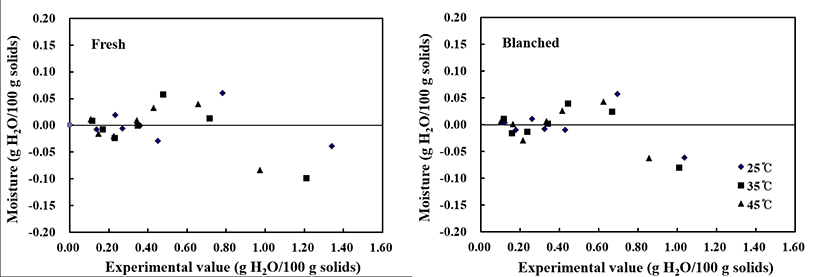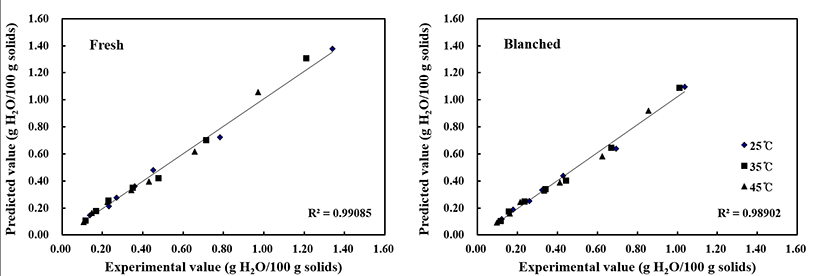Introduction
Yacon (Smallanthus sonchifolius) is a tuberous root, rich in inulin and fructo-oligosaccharides (FOS), which are short polymers of fructose (1). FOS have low calorific value, and have been designated as prebiotics and soluble fiber, as they are not hydrolyzed by human digestive enzymes (2). Increasing interest and growing consumption of yacon is related to its beneficial effects on human health as well as various health-promoting properties. Yacon tubers have long been used as a traditional folk treatment to control hyperglycemia, kidney problems, and for skin rejuvenation (3), and they have been reported to have antioxidant, anti-inflammatory, antimicrobial, and anti-cancer activities (4).
For successful application of flour in various industry fields, knowledge of moisture adsorption isotherms, which describe the inherent relationship between aw and moisture content in food materials is essential for drying, storage, packaging, and shelf-life prediction (5). Moreover, proper modeling for predicting the relationship between equilibrium moisture, water activity, and temperature provides information about the product conditions during storage, especially for dehydrated foods (6).
Numerous studies on the moisture sorption characteristics of dehydrated food materials have been previously conducted, and researchers have proposed several theoretical, semi-theoretical, and empirical models to describe their behaviors. Choosing a mathematical model to describe the integrated hygroscopic properties of dehydrated food materials to be stored is important for the design of processing equipment as well as the optimization of storage and drying conditions. However, information on the moisture sorption characteristics of yacon flour is very limited in the literature and no experimental data are available especially for pre-treated yacon samples.
The objectives of the present study were to establish the relationship between the equilibrium moisture content (EMC) and aw in flours from fresh and blanched yacon tubers at three different temperatures (25, 35, and 45℃) and to determine the best moisture sorption isotherm equation to fit the experimental sorption data.
Materials and methods
Fresh yacon tubers, produced in Jangsu, Jeonbuk, Korea, were purchased online from Sun Village Market (Gwangju, Korea) and placed in a 4℃ refrigerator prior to the experiments. Yacon tubers were either rinsed in fresh water or rinsed and blanched by immersing in 80℃ distilled water for 2 min, drained on a stainless steel mesh screen for 3 min to remove excess water, peeled and cut into cylinders with a thickness of approximately 5.3 mm, and then immediately dried at 60℃ using a hot-air drying oven (WFO-700W, Tokyo Rikakikai Co., Ltd., Tokyo, Japan) for 12 h. Dehydrated yacon tubers were milled using an analytical mill (M20, IKA, Staufen, Germany) and sieved to yield particle sizes less than 300 μm.
Duplicate samples, about 2.0 g each, were taken and placed on glass petri dishes in desiccators with seven different saturated salt solutions of known relative humidity (7). The saturated salt solutions consisted of LiCl, CH3COOK, MgCl2, K2CO3, Mg(NO3)2, NaNO2, and NaCl, allowing a aw ranging from 0.11 to 0.75. These desiccators were kept in three incubators maintained at 25, 35, and 45℃, respectively. Samples were weighed until they reached equilibrium conditions (when three consecutive weight measurements gave the same reading). All analyses were carried out in duplicate and expressed on a dry basis, g H2O/100 g solids.
Selected sorption isotherm equations, including BET, GAB, Oswin, Halsey, Henderson, Chung, and Smith, which are most widely used for food materials, were used (8). The coefficients of sorption equations were determined by nonlinear regression within the aw of 0.11 to 0.75, whereas the BET equation was fitted to aw up to 0.45. The goodness of fit of these equations was verified by the coefficient of determination (R2) and by the mean relative percentage deviation modulus (E, %) according to Eq. 1 (9).
Where n is number of experimental observations while mi and mpi are experimental and predicted moisture content values, respectively. The model indicates a reasonably good fit for most practical purposes if E% values are below 10% (10).
The well-known BET (Eq. 2) and GAB (Eq. 3) equations were applied to determine the monolayer moisture values of the samples in this study. These models are expressed and rearranged as given below:
Where me is the equilibrium moisture content (%, dry basis); m0 is the monolayer moisture content (%, dry basis); aw is the water activity; and CB, CG and K are thermodynamic constant(s) for BET and GAB equation, respectively.
For example, the GAB (Eq. 3) can be rearranged to GAB polynomial expression (Eq. 4) to calculate the thermodynamic constants and monolayer moisture content (11).
The coefficient a, b, and c can be calculated by nonlinear regression analysis using Eqs. 5-7.
Results and discussion
The experimental results obtained for water sorption in fresh and blanched yacon samples at different temperatures are shown in Fig. 1 (12). The experimental data indicate that the EMC decreased with increasing temperature to a constant aw. This trend can be attributed to a reduction in the total number of active sites for water binding due to physical and/or chemical changes induced by temperature, which influence the mobility of water molecules and the dynamic equilibrium between the vapor phase and adsorbed phase (13). This suggests that yacon powder became less hygroscopic as temperature increased.

At a constant temperature, the EMC of both fresh and blanched yacon samples increased with aw, and an intersection point was observed at a aw around 0.6. This behavior manifested in the form of a J-shaped curve, which is a Type III isotherm. At low and intermediate aw, EMC increased linearly with aw, while at high aw, EMC increased rapidly with aw. Type III isotherms are typical of sugar-rich products since sugars can sorb more water and overcome the negative effect of temperature at higher hydration level (14). This type of isotherm occurs when the binding energy between water molecules is higher than that of the monolayer, probably due to the high amounts of carbohydrates and sugars (15). The obtained sorption isotherm curves agree well with those of high sugar content materials since yacon tubers contain significant amounts of FOS (1). On the contrary, food materials with low sugar content or high starch content do not display an intersection point with an increase in aw or temperature (16).
The blanched samples showed lower values for moisture equilibrium (smaller capacity for water sorption) than the fresh ones under most conditions. In other words, blanched yacon samples had a smaller capacity for water sorption due to the blanching process. Most likely, the high temperature used in blanching could have affected the sorption sites by altering protein structure and by enhancing the interactions of proteins with carbohydrates and lipids; consequently, the available sites of water adsorption decreased due to protein hydrophobicity (17). In addition, the lower EMCs for the blanched samples could be attributed to the lesser crystallinity and content of undamaged starch granules relative to those of the fresh ones (18), this also being associated with the loss of soluble solids during the pre-treatment (19). A similar blanching effect on sorption isotherms has been reported for African arrowroot lily (18), pumpkin (19), spinach leaves (20), and potato (21). Johnson and Brennan (22) indicated that the sorptive capacity of a product can be affected by denaturation processes such as heating, desalting, and pH changes. Fresh yacon samples had higher EMC than blanched ones when aw was above about 0.40.
The sorption isotherm curves of fresh and blanched yacon samples are described as the EMC against water activities at different temperatures. Six mathematical models were used to fit the curves using nonlinear regression analysis, and the obtained parameter values are shown in Table 1. The BET model satisfactorily described the EMC of both the fresh and blanched yacon samples in the aw range up to 0.43, as the hypothesis of the correct fit cannot be verified above this level (23). The GAB and Halsey models showed good fit (R2>0.98); however, the Chung and Smith models did not satisfactorily fit the experimental data. The GAB or Halsey model best described the experimental data over the whole range of aw and temperatures, and it was the most suitable for the sorption isotherms of both yacon samples based on lowest relative errors (E<6.3%).
The residual plot distributions for the GAB equation for the fresh and blanched yacon samples at all temperatures are shown in Fig. 2. A model is considered acceptable if the residuals are uniformly scattered around the horizontal value of zero without showing systematic tendency towards a clear pattern (24). The residuals for the GAB model indicated no pattern distributions for the fresh and blanched yacon samples, and they were randomly scattered around zero. However, some large residuals existed at higher moisture content data points. These points are most likely outliers, as they did not exert considerable effects in the regression analyses (25). As also shown in Fig. 3, the GAB model provided a good fit to the experimental data for water sorption of both samples at all temperatures (R2>0.99).


According to the BET and GAB equations (theoretical models), the monolayer moisture values (m0), an important parameter in food deterioration for food systems can be estimated by fitting the sorption data. The m0 values obtained for fresh yacon flours ranged from 0.23% to 0.26% for the BET model and from 0.20% to 0.26% for the GAB model, whereas values for blanched yacon flours ranged from 0.22% to 0.26% for the BET model and from 0.20% to 0.27% forthe GAB model. These results are similar to those for cupuassu (Theobroma grandiflorum) powder at 15-35℃, with m0 values of 0.28-0.67% (26). The monolayer moisture values from the GAB model were lower than the values estimated by the BET model, whose behavior was reported for quince (27). The monolayer values are important since they represent water molecules that are adsorbed to form a monolayer on the sorption sites (23). At this ideal moisture content in boththe processes of drying and material storage, product stability will be guaranteed by avoiding chemical and biological reactions (9).
Sorption behavior of moisture in materials can be derived from theoretical interpretation of the GAB parameters (23). The CB parameter, which indicates the difference in chemical potential between water molecules that have been adsorbed in the first layer and water molecules adsorbed in the subsequent layers (28), presented lower values with an increase in temperature, demonstrating that breakage of the monolayer bonds was temperature-dependent. The parameter K represents the difference in chemical potential between bulk liquid water molecules and molecules adsorbed in the multilayer (28). The values ranged from 1.05 to 1.14 and from 0.99 to 1.10 for the fresh and blanched yacon samples, respectively. When K values were close to 1, there was almost no distinction between the multilayer molecules and liquid molecules, which show the same characteristics as the molecules in the bulk liquid (28). In comparison with CB and K values, CB values were much higher than K values, indicating that the heat of sorption of the first layer was larger than that of the multilayer (17).
요 약
야콘 분말의 이상적인 저장조건을 규명하기 위한 기초자료로서 저장상대습도(11-75%) 및 온도(25℃, 35℃, 45℃)에 따른 생 및 데친 야콘 분말의 흡습에 미치는 영향을 조사하고 그 특성을 모델링하였다. 생 및 데친 야콘 분말의 등온흡습곡선은 type III 곡선을 나타내었으며, 데친 시료의 평형수분함량은 생 시료에 비해 낮은 것으로 나타났다. GAB식으로부터 예측한 대부분의 단분자층 수분함량은 BET식으로부터 예측한 값보다 낮은 것으로 나타났으며, 생 및 데친 시료의 값은 유사하거나 일정한 패턴의 차이는 발견되지 않았다. 실험이 수행된 조건하에서 GAB와 Halsey 모델이 생 및 데친 야콘 분말의 흡습특성을 가장 잘 예측할 수 있는 것으로 확인되었다. 이러한 실험결과는 야콘의 건조가공 및 저장의 최적조건을 도출하기 위한 중요한 자료로 사용될 수 있을 것으로 판단된다.
